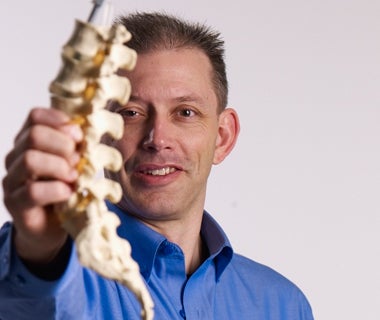
Keeping back pain at bay
Fill a room with 100 people and you can bet your bottom dollar 80 will have a tale to tell about back pain. Jack Callaghan is trying to answer why that is, and find ways to change it.

Fill a room with 100 people and you can bet your bottom dollar 80 will have a tale to tell about back pain. Jack Callaghan is trying to answer why that is, and find ways to change it.
By Christian Aagaard For Communications & Public Affairs
 Why lower-back injury is so prevalent, and what can be done to reduce it, preoccupies Jack Callaghan and his research team at the University of Waterloo. A professor of kinesiology in the Faculty of Applied Health Sciences, Callaghan has held the Canada Research Chair in Spine Biomechanics and Injury Prevention since 2003.
Why lower-back injury is so prevalent, and what can be done to reduce it, preoccupies Jack Callaghan and his research team at the University of Waterloo. A professor of kinesiology in the Faculty of Applied Health Sciences, Callaghan has held the Canada Research Chair in Spine Biomechanics and Injury Prevention since 2003.
“Hurt your arm, you can usually do something else,’’ he says. “Hurt your back, and it can impact everything you do ... Once you’ve had it, the chance of getting it again is very, very high.”
In Canada’s historic manufacturing economy, back injuries tended to come from awkward movements lifting heavy weight.
Now, with so many people earning a paycheque behind a desk, sitting has become the prime suspect, especially in cases of lower back pain. Back trouble diminishes the lives of those suffering from it and costs the economy billions of dollars in compensation and lost productivity.
Discoveries made in the Spine Biomechanics Laboratories housed in B.C. Matthews Hall are changing the work habits of police officers. Front-line officers spend much of a 12-hour shift seated in cruisers, bending and twisting as they jot notes and use on-board computers.
By redesigning the layout of this rolling office — improving the driver’s seat and attaching the computer to an adjustable arm, for example — Dr. Callaghan’s team is tackling a troublesome occupational hazard: injuries to discs and soft tissues in the lumbar spine that can develop into chronic low back pain.
Research in two labs ranges from fundamental tissue injury examining isolated spinal tissues, to field research assessing occupational exposures for police officers, assembly line workers, office workers and others.
The object isn’t to find a quick cure or treatment for back pain. Back injuries often elude completely successful treatment because they are complex and difficult to diagnose.
But designing better work stations and getting people to be aware of their work habits shifts the focus to prevention, Dr. Callaghan says. He suggests workers:
Sensible exercise, he adds, “is as good as anything you can do.”
“You want to stop this before it happens.”

Read more
Special issue of Waterloo Magazine celebrates women who lead, and explores equity in education and the workplace

Read more
Waterloo Magazine, Fall 2014: Smarter cars, high-flying students and better sex for those with bad backs

Read more
Commuters who are physically active are happier than commuters who don’t make time for exercise, according to Waterloo study
The University of Waterloo acknowledges that much of our work takes place on the traditional territory of the Neutral, Anishinaabeg, and Haudenosaunee peoples. Our main campus is situated on the Haldimand Tract, the land granted to the Six Nations that includes six miles on each side of the Grand River. Our active work toward reconciliation takes place across our campuses through research, learning, teaching, and community building, and is co-ordinated within the Office of Indigenous Relations.